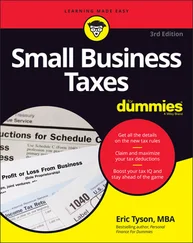Eric Tyson - Investing All-in-One For Dummies
Здесь есть возможность читать онлайн «Eric Tyson - Investing All-in-One For Dummies» — ознакомительный отрывок электронной книги совершенно бесплатно, а после прочтения отрывка купить полную версию. В некоторых случаях можно слушать аудио, скачать через торрент в формате fb2 и присутствует краткое содержание. Жанр: unrecognised, на английском языке. Описание произведения, (предисловие) а так же отзывы посетителей доступны на портале библиотеки ЛибКат.
- Название:Investing All-in-One For Dummies
- Автор:
- Жанр:
- Год:неизвестен
- ISBN:нет данных
- Рейтинг книги:3 / 5. Голосов: 1
-
Избранное:Добавить в избранное
- Отзывы:
-
Ваша оценка:
- 60
- 1
- 2
- 3
- 4
- 5
Investing All-in-One For Dummies: краткое содержание, описание и аннотация
Предлагаем к чтению аннотацию, описание, краткое содержание или предисловие (зависит от того, что написал сам автор книги «Investing All-in-One For Dummies»). Если вы не нашли необходимую информацию о книге — напишите в комментариях, мы постараемся отыскать её.
Investing All-in-One For Dummies
.
Dummies
Investing All-in-One For Dummies
Investing All-in-One For Dummies
Investing All-in-One For Dummies — читать онлайн ознакомительный отрывок
Ниже представлен текст книги, разбитый по страницам. Система сохранения места последней прочитанной страницы, позволяет с удобством читать онлайн бесплатно книгу «Investing All-in-One For Dummies», без необходимости каждый раз заново искать на чём Вы остановились. Поставьте закладку, и сможете в любой момент перейти на страницу, на которой закончили чтение.
Интервал:
Закладка:
The sooner you start to save, the less painful it is each year to save enough to reach your goals, because your contributions have more years to compound. Each decade you delay saving approximately doubles the percentage of your earnings that you need to save to meet your goals. If saving 5 percent per year in your early 20s gets you to your retirement goal, waiting until your 30s to start may mean socking away approximately 10 percent to reach that same goal; waiting until your 40s means saving 20 percent. Start saving and investing now!
Surveying retirement account choices
If you earn employment income (or receive alimony), you have options for putting money away in a retirement account that compounds without taxation until you withdraw the money. In most cases, your contributions to these retirement accounts are tax-deductible. This section reviews your options.
Company-based retirement plans
Larger for-profit companies generally offer their employees a 401(k) plan, which typically allows saving up to $19,500 per year (for tax year 2021). Many nonprofit organizations offer their employees similar plans, known as 403(b) plans. Contributions to both traditional 401(k) and 403(b) plans are deductible on both your federal and state taxes in the year that you make them. Employees of nonprofit organizations can generally contribute up to 20 percent or $19,500 of their salaries, whichever is less.
There’s a benefit in addition to the up-front and ongoing tax benefits of these retirement savings plans: Some employers match your contributions. (If you’re an employee in a small business, you can establish your own SEP-IRA.) Of course, the challenge for many people is to reduce their spending enough to be able to sock away these kinds of contributions.
Some employers are offering a Roth 401(k) account, which, like a Roth IRA (discussed in the next section), offers employees the ability to contribute on an after-tax basis. Withdrawals from such accounts generally aren’t taxed in retirement.
If you’re self-employed, you can establish your own retirement savings plans for yourself and any employees you have. Simplified Employee Pension-Individual Retirement Accounts (SEP-IRAs) allow you to put away up to 20 percent of your self-employment income up to an annual maximum of $58,000 (for tax year 2021).
Individual Retirement Accounts
If you work for a company that doesn’t offer a retirement savings plan, or if you’ve exhausted contributions to your company’s plan, consider an Individual Retirement Account (IRA). Anyone who earns employment income or receives alimony may contribute up to $6,000 annually to an IRA (or the amount of your employment income or alimony income, if it’s less than $6,000 in a year). A nonworking spouse may contribute up to $6,000 annually to a spousal IRA.
Your contributions to an IRA may or may not be tax-deductible. For tax year 2021, if you’re single and your adjusted gross income is $66,000 or less for the year, you can deduct your full IRA contribution. If you’re married and you file your taxes jointly, you’re entitled to a full IRA deduction if your AGI is $105,000 per year or less.
 If you can’t deduct your contribution to a standard IRA account, consider making a contribution to a nondeductible IRA account called the Roth IRA. Single taxpayers with an AGI less than $125,000 and joint filers with an AGI less than $198,000 can contribute up to $6,000 per year to a Roth IRA. Although the contribution isn’t deductible, earnings inside the account are shielded from taxes, and unlike withdrawals from a standard IRA, qualified withdrawals from a Roth IRA account are free from income tax.
If you can’t deduct your contribution to a standard IRA account, consider making a contribution to a nondeductible IRA account called the Roth IRA. Single taxpayers with an AGI less than $125,000 and joint filers with an AGI less than $198,000 can contribute up to $6,000 per year to a Roth IRA. Although the contribution isn’t deductible, earnings inside the account are shielded from taxes, and unlike withdrawals from a standard IRA, qualified withdrawals from a Roth IRA account are free from income tax.
 Should you be earning a high enough income that you can’t fund a Roth IRA, there’s an indirect “backdoor” way to fund a Roth IRA. First, you contribute to a regular IRA as a nondeductible contribution. Then, you can convert your regular IRA contribution into a Roth IRA. Please note that this so-called backdoor method generally only makes sense if you don’t have other money already invested in a regular IRA because in that case, you can’t simply withdraw your most recent contribution and not owe any tax.
Should you be earning a high enough income that you can’t fund a Roth IRA, there’s an indirect “backdoor” way to fund a Roth IRA. First, you contribute to a regular IRA as a nondeductible contribution. Then, you can convert your regular IRA contribution into a Roth IRA. Please note that this so-called backdoor method generally only makes sense if you don’t have other money already invested in a regular IRA because in that case, you can’t simply withdraw your most recent contribution and not owe any tax.
Annuities: Maxing out your retirement savings
What if you have so much cash sitting around that after maxing out your contributions to retirement accounts, including your IRA, you still want to sock more away into a tax-advantaged account? Enter the annuity. Annuities are contracts that insurance companies back. If you, the investor (annuity holder), should die during the so-called accumulation phase (that is, before receiving payments from the annuity), your designated beneficiary is guaranteed reimbursement of the amount of your original investment.
Annuities, like IRAs, allow your capital to grow and compound tax-deferred. You defer taxes until you withdraw the money. Unlike an IRA, which has an annual contribution limit of a few thousand dollars, an annuity allows you to deposit as much as you want in any year — even millions of dollars, if you’ve got millions! As with a Roth IRA, however, you get no up-front tax deduction for your contributions.
 Because annuity contributions aren’t tax-deductible, and because annuities carry higher annual operating fees to pay for the small amount of insurance that comes with them, don’t consider contributing to one until you’ve fully exhausted your other retirement account investing options. Because of their higher annual expenses, annuities generally make sense only if you won’t need the money for 15 or more years.
Because annuity contributions aren’t tax-deductible, and because annuities carry higher annual operating fees to pay for the small amount of insurance that comes with them, don’t consider contributing to one until you’ve fully exhausted your other retirement account investing options. Because of their higher annual expenses, annuities generally make sense only if you won’t need the money for 15 or more years.
Selecting retirement account investments
When you establish a retirement account, you may not realize that the retirement account is simply a shell or shield that keeps the federal, state, and local governments from taxing your investment earnings each year. You choose what investments you want to hold inside your retirement account shell.
You may invest the money in your IRA or self-employed plan retirement account (SEP-IRAs and so on) in stocks, bonds, mutual funds, and some other common investments, including bank accounts. Mutual funds (offered in most employer-based plans) and exchange-traded funds (ETFs) are ideal choices because they offer diversification and professional management. See Book 5for more on mutual funds and ETFs.
Chapter 2
Minimizing Your Taxes When Investing
IN THIS CHAPTER
 Seeing how investments are taxed
Seeing how investments are taxed
 Considering tax issues when selling an investment
Considering tax issues when selling an investment
You should pay attention to tax issues when making investing decisions. Actually, let’s rephrase that. Like plenty of other folks, you could ignore or pay half attention to taxes on your investments. Unless you enjoy paying more taxes, however, you should understand and consider tax ramifications when choosing and managing your investments over the years.
Читать дальшеИнтервал:
Закладка:
Похожие книги на «Investing All-in-One For Dummies»
Представляем Вашему вниманию похожие книги на «Investing All-in-One For Dummies» списком для выбора. Мы отобрали схожую по названию и смыслу литературу в надежде предоставить читателям больше вариантов отыскать новые, интересные, ещё непрочитанные произведения.
Обсуждение, отзывы о книге «Investing All-in-One For Dummies» и просто собственные мнения читателей. Оставьте ваши комментарии, напишите, что Вы думаете о произведении, его смысле или главных героях. Укажите что конкретно понравилось, а что нет, и почему Вы так считаете.












